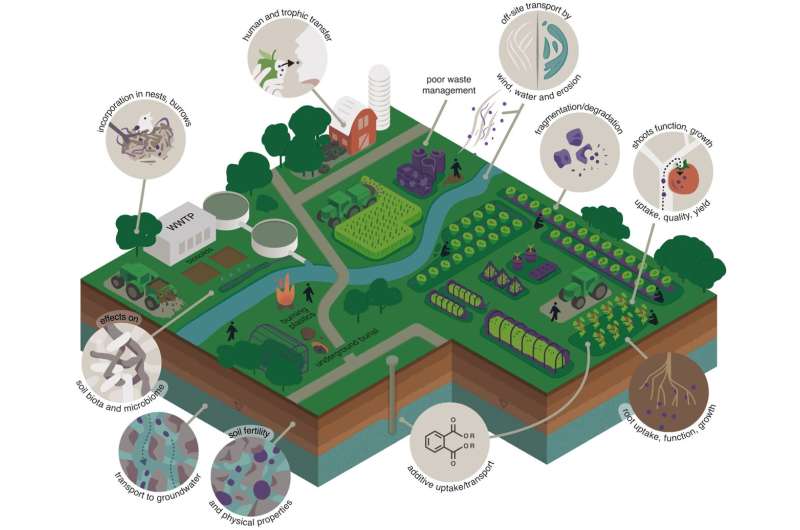This article has been reviewed according to Science X's editorial process and policies. Editors have highlighted the following attributes while ensuring the content's credibility:
fact-checked
peer-reviewed publication
trusted source
proofread
Q&A: Finding more sustainable ways to use plastics in agriculture

Every year, according to the United Nations Food and Agriculture Organization, some 12.5 million tonnes of plastic are used in agricultural production worldwide. Plastic is a boon to farmers, but leads to large quantities of macro-, micro- and nanoplastics accumulating in soils and other receiving environments. The particles even seep into the food chain.
Recognizing that plastics pose a growing threat to soil function and the natural environment overall, in an article this fall in Communications Earth & Environment an international group of scientists highlighted the urgent need for a more sustainable use of the materials in agricultural food production.
One of those scientists is Kevin Wilkinson, a professor in Université de Montréal's Department of Chemistry. We asked him to explain the situation and what the article's signatories propose as solutions.
How are plastics used in agricultural production?
Plastics are used in a number of different ways to boost crop production. Mulch film accounts for 50 percent of the mass of all agricultural plastics, but the applications also include nets, storage bins and water-efficient irrigation systems.
In many ways, plastic helps improve yields while reducing the environmental impact of farming.
For example, without mulch film, China would need an additional 3.9 million hectares of arable land to produce the same amount of food. The plastic film increases soil temperature and improves nutrient absorption, which allows farmers to plant and harvest crops earlier.
Plastic mulch films are also used in organic agriculture because they help suppress weed and insect infestation without synthetic pesticides.
What are the risks associated with the use of plastic in agriculture?
Plastic is a generic term used to describe materials made primarily from one or more organic polymers. They also contain additives that give the materials specific sought-after properties. Conventional polymers such as polyethylene, polypropylene and polyvinyl chloride (PVC) are persistent in the environment.
Agricultural plastics composed of these conventional polymers can break down into micro- and nanoplastics, which can accumulate in soils over time, be absorbed by plants and wildlife, or make their way into adjacent environments, including waterways.
Plastic mulch films are usually made from low-density polyethylene, but they're sometimes made from other polymers like PVC or ethylene-vinyl acetate copolymers.
If any mulch film gets left behind after use, persistent plastic residues accumulate in the soil and chemical additives can leach out. Repeated applications can therefore lead to a build-up of residues and additives that adversely affects soil productivity and health.
What's more, tiny plastic particles can be absorbed by plants, while larger fragments can stick to the outside of roots and end up being ingested by people when they eat root vegetables.
Is that why you're urging society take action and find sustainable solutions?
That's right. With the global population expected to reach 10 billion by 2050, food security challenges will drive up the need for increased agricultural productivity—so we can expect the use of plastics to become more widespread.
But agriculture is already responsible for 29 percent of greenhouse gas emissions, 30 percent of energy consumption, 33 percent of land use, 70 percent of groundwater extraction and 75 percent of deforestation. All these factors contribute to global warming, which negatively impacts crop yields.
What solutions and alternatives do you propose?
Plastics need to be used more sustainably in agricultural practices. This means recovering and reusing materials, selectively applying safe biodegradable plastics, and gradually phasing out toxic additives.
We're already seeing certified biodegradable mulch films that can be buried in the soil after crops are harvested and that will fully decompose into carbon dioxide and microbial biomass.
We also need to increase reuse and recycling rates for agricultural plastic waste, as current levels are at less than 10 percent.
Finally, it's crucial that governments and stakeholders get on board with the UN Global Plastics Treaty, which aims to reduce plastic pollution across the board, including in the agricultural sector.
To make this possible, we need an international regulatory framework that takes into account the entire life cycle of agricultural plastics and establishes stringent and legally binding requirements for all member states of the UN Environment Assembly. This regulatory framework must be revised regularly to make sure it's aligned with the latest research.
Journal information: Communications Earth & Environment
Provided by University of Montreal





















